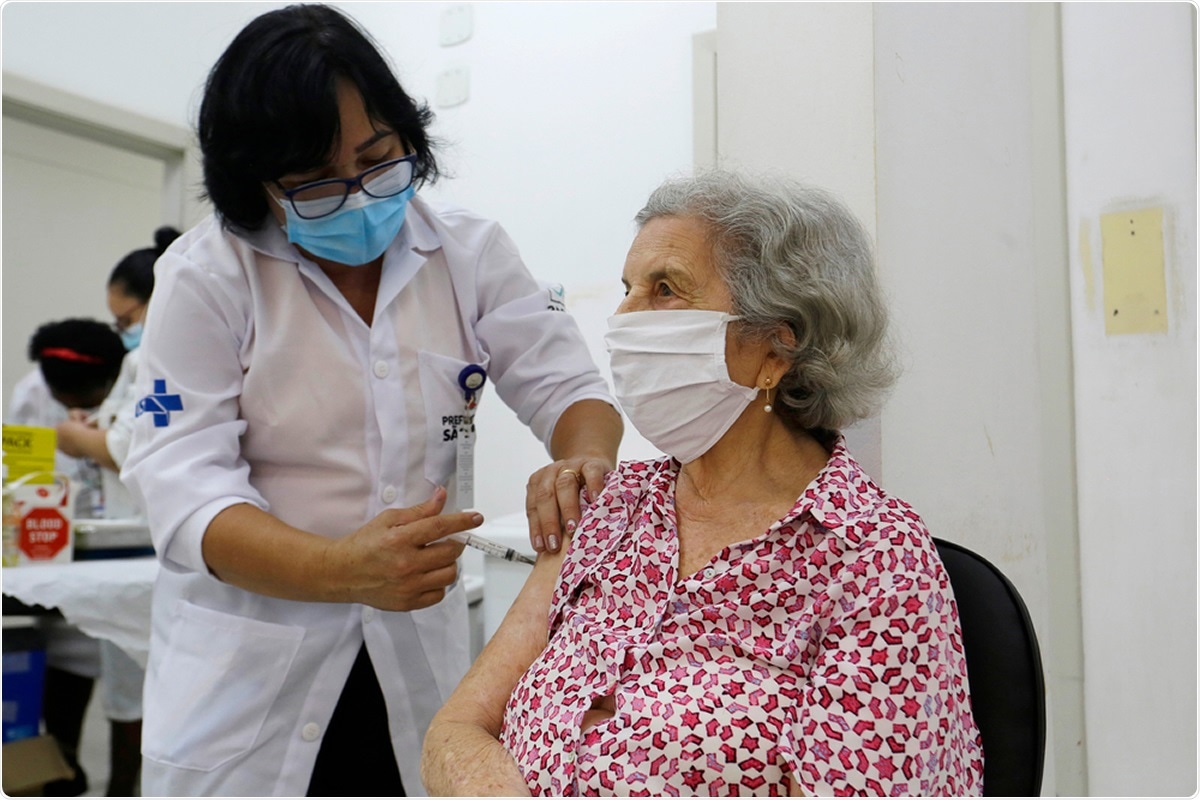Several vaccines against the severe acute respiratory syndrome coronavirus 2 (SARS-CoV-2) with various distinct antigen delivery systems (non-replicating viral vector, protein subunit, inactivated virus, and mRNA) have been developed since the advent of the COVID-19 (coronavirus disease 2019) pandemic.
The CoronaVac (Sinovac Life Sciences, Beijing, China) is an inactivated virus. As of April 2021, it is the most administered vaccine in Brazil.
Researchers from the Federal University of Paraná, Brazil, looked into the seroconversion rate after vaccination with the CoronaVac. Using immunoassays, they measured the immunoglobulins (IgG) for anti-nucleocapsid protein (anti-N) antibodies and anti-spike-1 (anti-S1) protein antibodies.
A pre-print version of the research paper is available on the medRxiv* server while the article undergoes peer review.

“As the vaccine was administered across the complete range of ethnicities, comorbidities, and ages, phase I/II trial results may not perfectly reflect vaccine response times and seroconversion rates,” said the researchers.
They found that the CoronaVac has a high seroconversion rate, evaluated in the healthcare workers (HCW) population.
In the study, the researchers also accounted for the comorbidities of the healthcare workers. Individuals with medical conditions such as cancer, chronic kidney/lung disease, COPD (chronic obstructive pulmonary disease), asthma, etc., are more likely to get severe COVID-19. The HCWs with comorbidities showed similar responses to the vaccine.
The study cohort included 133 participants recruited at the Complexo Hospital de Clínicas, UFPR, Clinical Laboratory, Curitiba, Brazil, during the vaccination of healthcare workers in this city. The serum samples were collected on days 0 (first dose application), +10, +20 (second dose application), and +40.
While the researchers used the Chemiluminescent Microparticle Immunoassay (CMIA) Architect-I System for anti-nucleocapsid protein (anti-N) IgG (Abbott, Sligo, Ireland), they used the Enzyme-Linked Immunosorbent Assay (EIA) for IgG anti-S1 spike-protein receptor-binding domain (RBD) (Euroimmun, Lübeck, Germany).
In the study, they observed robust antibody production only after day 40 of CoronaVac vaccination.
Although the seroconversion to S1 protein on day 0 differed (reactive (n=16) and non-reactive (n=117), on day +40, it averaged the same.
While two immunosuppressed HCW did not show seroconversion (probably due to rituximab), two HCWs who were not immunosuppressed also did not present seroconversion.
Of the two cases which reported no seroconversion at day +40, one of them presented a delayed response on day +60. The researchers called for further studies to explain the lack of seroconversion to understand what interfered with the immune response.
This study also confirms previous reports of research post-vaccination with mRNA vaccine in individuals with and without previous COVID-19: no difference in individual antibody response regardless of previous infection.
“Both natural infection and vaccination act on the immune system in complex ways, stimulating the production of non-neutralizing antibodies (with their own specific actions) as well as TCD4+ and TCD8+ T cells, which also act to protect against COVID-19.”
SARS-CoV-2 has now infected over 168 million individuals and caused over 3.5 million deaths the world over. Despite the vaccine administration across the globe, many challenges are presented in overcoming this pandemic. One of the crucial paths to develop an effective solution towards this is to understand the immunological responses generated in the body upon infection and vaccination.
SARS-CoV-2 stimulates a rapid antibody response in the infected individuals. While the RBD (receptor binding domain) region of the S1 protein is the prominent antigenic target, it is also highly mutating. Several mutations in this region have produced new virus variants, as previously described: P.1, P.2, B.1.351, B.1.1.7, and B.1.325.
Comparatively, the N-protein is observed to have lower mutation levels. “Therefore, seroconversion of N-protein antibodies may be an alternative for the vaccine industry to produce efficient vaccines for circulating strains, including those that may arise in the future,” reasoned the researchers in this study.
This study demonstrated high seroconversion in healthcare workers from Brazil, 40 days post-vaccination with CoronaVac. The researchers discussed the limitations of the study and further possible courses in the paper.
The study provides important data on the seroconversion rate; for CoronaVac it is 97% for the anti-S1 IgG in HCWs, which is similar or lower to the seroconversion rates observed in phase III studies of other vaccine candidates for SARS-CoV-2.
- SARS-CoV-2 vaccination with CoronaVac: seroconversion rate in healthcare workers after 40 days, Lucas Bochnia-Bueno, Sergio Monteiro De Almeida, Sonia Mara Raboni, Douglas Adamoski, Ludmilla Louise Moreira Amadeu, Suzana Carstensen, Meri Bordignon Nogueira, medRxiv 2021.05.20.21255825; doi: https://doi.org/10.1101/2021.05.20.21255825, https://www.medrxiv.org/content/10.1101/2021.05.20.21255825v1
Posted in: Drug Trial News | Medical Research News | Disease/Infection News
Tags: Antibodies, Antibody, Antigen, Assay, Asthma, Cancer, Chronic, Chronic Obstructive Pulmonary Disease, Coronavirus, Coronavirus Disease COVID-19, Enzyme, Healthcare, Hospital, Immune Response, Immune System, Immunoassay, Immunoassays, Kidney, Laboratory, Lung Disease, Mutation, Pandemic, Protein, Receptor, Research, Respiratory, Rituximab, SARS, SARS-CoV-2, Severe Acute Respiratory, Severe Acute Respiratory Syndrome, Syndrome, Vaccine, Viral Vector, Virus

Written by
Dr. Ramya Dwivedi
Ramya has a Ph.D. in Biotechnology from the National Chemical Laboratories (CSIR-NCL), in Pune. Her work consisted of functionalizing nanoparticles with different molecules of biological interest, studying the reaction system and establishing useful applications.
Source: Read Full Article






